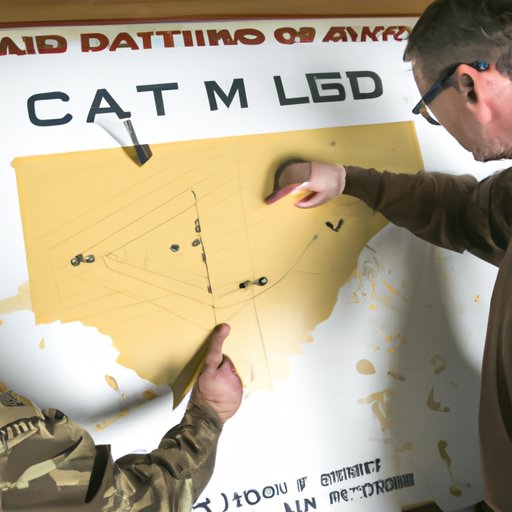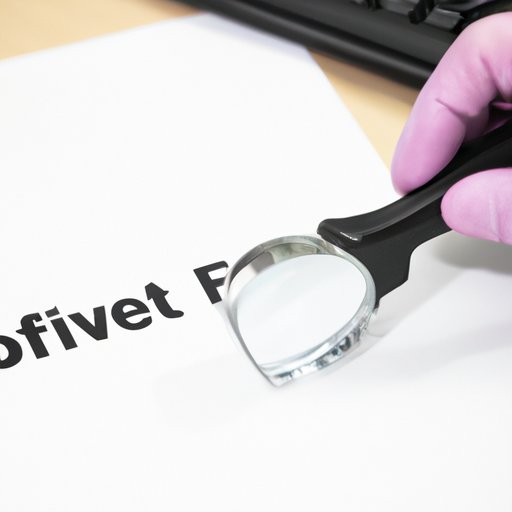Introduction
Forensic science is a branch of science that uses scientific methods to analyze and investigate physical, digital, and biological evidence from crime scenes. It is used by law enforcement and other investigative agencies to uncover the truth about criminal activity and solve cases. This article will explore the importance of forensic science in crime scene investigation and examine how it has been used to identify suspects, establish timelines and reconstruct events, and more.
Examining Physical Evidence from Crime Scenes
Physical evidence is one of the most important pieces of evidence collected at a crime scene. It can provide clues as to who was involved in the crime, what happened, and when it happened. Investigators use a variety of techniques to collect and analyze physical evidence, including fingerprint analysis, ballistics analysis, and DNA analysis.
Fingerprints are often left behind at a crime scene and can be used to identify the suspect. Fingerprint analysis involves comparing the fingerprints found at the crime scene with those of known suspects. If a match is found, it can be used to link the suspect to the crime.
Ballistics analysis is another important tool used in crime scene investigation. It involves examining the trajectory of bullets or weapons used in a crime. By analyzing the trajectory of the bullet or weapon, investigators can determine the type of weapon used and the angle of attack.
DNA analysis is also used to collect evidence from a crime scene. DNA analysis involves collecting and analyzing samples of skin cells, saliva, blood, and other biological materials found at the scene. By comparing the DNA found at the scene to the DNA of known suspects, investigators can link suspects to the crime.
Analyzing Digital Evidence from Computers and Phones
Digital evidence is an increasingly important part of crime scene investigation. Digital evidence includes data stored on computers, phones, and other electronic devices. It can provide valuable information about the activities of suspects and can be used to uncover cybercrimes such as identity theft, fraud, and other online crimes.
Investigators use a variety of techniques to analyze digital evidence, including network forensics, computer forensics, and mobile device forensics. Network forensics involves analyzing data on networks and computers to identify and track malicious activity. Computer forensics involves analyzing data stored on computers to uncover evidence of criminal activity. Mobile device forensics involves analyzing data stored on mobile devices such as phones and tablets to uncover evidence of criminal activity.
Investigating the Cause of Fires, Explosions, and Other Disasters
Forensic science can also be used to investigate the cause of fires, explosions, and other disasters. Fire investigators use a variety of techniques to determine the cause of a fire, including examining the debris, analyzing soot patterns, and using thermography to detect hot spots. Explosives experts analyze debris from explosions to determine the type of explosive used and the source of the explosion.
Forensic scientists also use chemical analysis to determine the cause of a disaster. Chemical analysis involves testing samples of debris, soil, water, and other materials to determine the presence of hazardous chemicals. This can help investigators determine whether a chemical spill or other environmental hazard caused the disaster.

Establishing Timelines for Crimes and Reconstructing Events
Forensic science can also be used to establish timelines for crimes and reconstruct events. Forensic investigators use a variety of techniques to establish timelines, including analyzing surveillance footage, interviewing witnesses, and examining phone records. These techniques can help investigators determine when and where a crime occurred and who was involved.
Forensic investigators also use a variety of techniques to reconstruct events. They can analyze physical evidence such as footprints and tire tracks to determine the movements of suspects and victims. They can also analyze blood spatter patterns to determine the type of weapon used and the angle of attack.

Identifying Unknown Victims of Crime or Disaster
Forensic science can also be used to identify unknown victims of crime or disaster. In cases where the victim’s body is too badly damaged to be identified, forensic scientists can use DNA analysis to compare the victim’s DNA to that of family members or other known individuals. This can help investigators identify the victim and provide closure for their family.
Forensic scientists can also use facial recognition software to compare the victim’s face to photos of missing persons. This can help investigators identify victims who have been missing for years.
Collecting DNA Evidence to Identify Suspects
DNA evidence is one of the most powerful tools used by investigators to identify suspects. DNA analysis involves collecting and analyzing samples of skin cells, saliva, blood, and other biological materials found at the scene. By comparing the DNA found at the scene to the DNA of known suspects, investigators can link suspects to the crime.
DNA evidence has been used to successfully identify suspects in numerous high-profile cases, including the Unabomber case and the O.J. Simpson trial. In both cases, DNA evidence was used to link suspects to the crime and bring them to justice.

Examining Blood Spatter Patterns to Determine Weapon Type and Angle of Attack
Blood spatter analysis is another important tool used by investigators to determine the type of weapon used and the angle of attack. Blood spatter analysis involves examining the size, shape, and direction of blood droplets at a crime scene. By analyzing these patterns, investigators can determine the type of weapon used and the angle of attack.
Blood spatter analysis has been used to successfully solve numerous cases, including the infamous “Night Stalker” case. In this case, investigators used blood spatter analysis to determine the type of weapon used and the angle of attack, which helped lead to the arrest and conviction of the suspect.
Conclusion
Forensic science is an essential tool for crime scene investigation and uncovering the truth. It can be used to examine physical, digital, and biological evidence from crime scenes to identify suspects, establish timelines, reconstruct events, and more. The importance of forensic science cannot be overstated and its use is only likely to increase in the future.
(Note: Is this article not meeting your expectations? Do you have knowledge or insights to share? Unlock new opportunities and expand your reach by joining our authors team. Click Registration to join us and share your expertise with our readers.)
